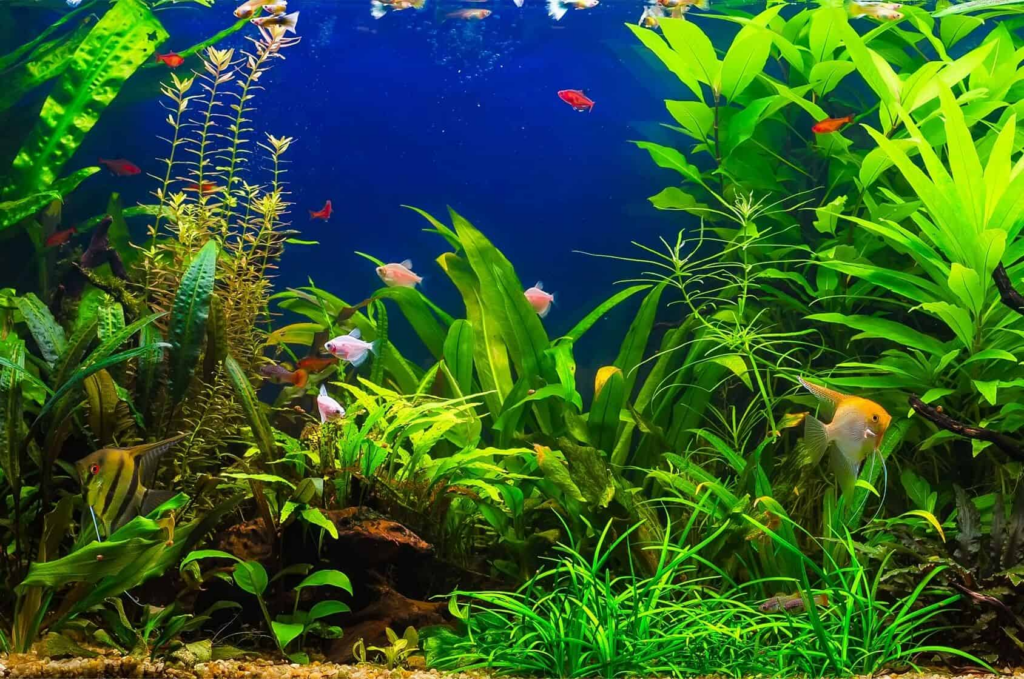When it comes to setting up a new fish tank, the decision of whether or not to incorporate real plants is an important one. Real plants, also known as live plants, can bring a multitude of benefits to a fish tank environment. In this article, we will showcase the importance and advantages of having real plants in fish tanks, as well as provide tips on choosing and caring for them.

What are real plants in fish tanks?
Real plants in fish tanks refer to aquatic plants that are grown in a submerged or partially submerged state within the aquarium. These plants play a crucial role in creating a balanced and healthy ecosystem for your fish.
Importance of having plants in fish tanks
Real plants offer a range of benefits that contribute to the overall well-being of the aquarium. Firstly, they provide natural filtration and oxygenation. Through the process of photosynthesis, plants absorb carbon dioxide from the water and release oxygen, ensuring a constant supply of fresh air for your fish.
Additionally, the presence of real plants improves water quality by absorbing excess nutrients and waste materials. This helps to reduce the accumulation of harmful substances, such as ammonia and nitrites, which can be detrimental to fish health.
Another advantage of having real plants is the reduction of algae growth. Live plants compete with algae for nutrients and sunlight, effectively limiting their growth and keeping the tank clean and algae-free.
Furthermore, real plants create a natural habitat for fish, allowing them to exhibit natural behaviors and providing places to hide and explore. This helps to alleviate stress and promote the overall well-being of your fish.

Types of real plants suitable for fish tanks
There are different types of real plants that can be incorporated into fish tanks, depending on their growth patterns and requirements.
Submerged plants, such as Anubias and Vallisneria, are rooted in the substrate and grow entirely below the water surface. They are excellent for oxygenation and provide shelter for fish.
Floating plants like Water lettuce and Duckweed are another option. They can absorb excess nutrients from the water and provide shade, reducing the intensity of light in the tank.
Rooted plants, such as Amazon swords and Java ferns, are planted in the substrate with their roots anchoring them. They add aesthetic appeal to the tank and serve as hiding places for fish.
Check out this guide to Easy Aquarium Plants for Beginners for our list of 10 easy to care for plants.
Factors to consider before choosing real plants for fish tanks
Prior to selecting real plants for your fish tank, there are a few important factors to consider.
Firstly, you need to ensure compatibility with the fish species in your tank. Some plants may not be suitable for certain fish due to differences in water parameters or their eating habits.
Furthermore, tank size and layout play a role in plant selection. Some plants can grow quite large and may not be suitable for smaller aquariums.
Lighting and nutrient requirements are also crucial factors to consider. Different plants have varying light and nutrient preferences, so it’s important to provide the appropriate conditions for their growth.

Maintenance and care tips for real plants in fish tanks
Proper care is essential to ensure the health and longevity of real plants in your fish tank.
Regular pruning and trimming help to control the growth of plants and prevent overcrowding. It is important to remove any dead or decaying plant material promptly.
Fertilization and nutrient supplementation are also necessary for optimal plant growth. This can be achieved through specialized aquatic plant fertilizers or by making use of natural fertilizers like fish waste or controlled-release granules.
Dealing with potential challenges, such as diseases or pests, is another aspect of plant care. Regular observation and swift action can help prevent and mitigate any issues that may arise.

Plant Selection & Placement Tips
When setting up your planted tank, the choice between artificial plants and natural aquarium plants is crucial. Artificial aquarium plants are low-maintenance, requiring no special lighting or CO2, making them perfect for beginners or those seeking ease of care.
Conversely, natural aquarium plants produce oxygen and significantly improve water quality, which is essential for a thriving aquarium. When selecting plants, consider a variety of plant species to enhance your aquarium’s biodiversity and visual appeal.
Tall plants are excellent for background placement, adding depth and a natural look to your tank. Proper selection and placement of plants ensure a well-maintained planted aquarium, fostering a healthy and aesthetically pleasing environment.

Common misconceptions about real plants in fish tanks
There are a few misconceptions surrounding the use of real plants in fish tanks that need to be addressed.
Contrary to belief, real plants do not harm fish. In fact, they provide numerous benefits that contribute to fish health and well-being.
Additionally, while it is true that real plants require some maintenance, they are not overly difficult to manage. With proper care and attention, they can thrive and beautify your fish tank.

Conclusion
Real plants bring a multitude of benefits to fish tanks, enhancing the overall well-being of both the fish and the aquarium ecosystem. They provide natural filtration, improve water quality, reduce algae growth, and create a natural habitat for fish.
By considering factors such as compatibility, tank size, lighting, and nutrient requirements, you can choose the right plants to suit your aquarium. With proper maintenance and care, these plants will thrive, adding beauty and functionality to your fish tank. So, don’t hesitate to explore the world of real plants and witness the positive impact they can have on your fish tank!


